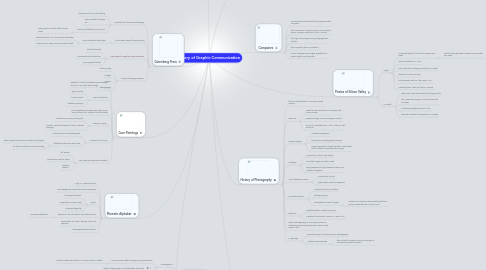
1. Hieroglyphics
1.1. Hieroglyphics
1.1.1. communicated about religion and government
1.1.1.1. military leaders also used it to communicate in battle
1.1.2. made of logo-graphic and alphabetic elements
1.2. Rosetta Stone
1.2.1. found by Napoleon when he invaded Egypt
1.2.2. has 3 languages on it
1.2.2.1. Egyptian Hieroglyphics
1.2.2.2. Demotic
1.2.2.3. Greek
1.2.3. currently resides in the British Museum
1.2.4. deciphered by Jean Francois Champollion
2. Cave Paintings
2.1. beautiful, colorful, detailed representations found in cave walls and ceilings
2.2. common themes
2.2.1. large animals
2.2.2. human hands
2.2.3. abstract paintings
2.3. paint created by mixing water, plant juice, animal blood, soil, charcoal, and hematite
2.4. Lascaux, France
2.4.1. most famous cave painting site
2.4.2. closed to public because of carbon dioxide damage
2.5. Chauvet Pont d'ARC
2.5.1. oldest known cave painting site
2.5.2. different techniques used here
2.5.2.1. walls scraped to become smoother and lighter
2.5.2.2. 3d effect created on some paintings
2.6. why cave paintings were created
2.6.1. tell stories
2.6.2. instructions used to teach
2.6.3. religious reasons
3. Phonetic Alphabet
3.1. 1 sign is 1 spoken sound
3.2. first widespread script because its simplicity
3.3. serifs
3.3.1. finishing off strokes
3.3.2. originated in ancient Italy
3.3.3. increased legibility
3.4. baseline is the line where most letters sit on
3.4.1. increases aesthetics
3.5. descenders are letters that go under the baseline
3.6. disintegrated class division
4. Gutenberg Press
4.1. Invented by Johannes Gutenberg
4.1.1. because of his love of reading
4.1.2. also invented oil-based ink
4.1.3. had his stuff taken by John Fust
4.1.3.1. wasn't given credit til after he was dead
4.2. first modern way of book printing
4.2.1. uses moveable metal type
4.2.1.1. better because it can be reproduced better
4.2.1.2. made from an alloy of many kinds of metal
4.3. a few ways it impacted communication
4.3.1. perfected script
4.3.2. increased book production
4.3.3. more people literate
4.4. 4 major printing processes
4.4.1. relief printing
4.4.2. intaglio
4.4.3. porous
4.4.4. lithograpghy
5. Linotype Machine
5.1. machine that creates slugs of type
5.2. allowed operators to set type mechanically
5.3. New node
5.4. Keys
5.4.1. Black- lowercase
5.4.2. White- uppercase
5.4.3. Blue- punctuation, digits, small capitals
5.5. allowed newspapers to make longer papers and more
5.6. New node
6. Cuneiform
6.1. Sumerians
6.1.1. Theocratic: ruled by priest or king
6.1.2. skilled artisans
6.1.3. music important part of life
6.2. Cunieform
6.2.1. made to track business transactions
6.2.2. written on clay tablets
6.2.2.1. 1. wet clay and flatten it
6.2.2.2. 2. write on it with reeds
6.2.2.3. 3. lie in the sun to dry
6.2.3. evolved from pictographs to wedge-shaped letters
7. Codex and Illuminated Manuscript
7.1. scrolls
7.1.1. constructed from 1 long piece of papyrus or several glued together
7.1.2. either simply rolled or had wooden rollers on each end
7.1.3. only allowed sequential use
7.2. Codex
7.2.1. covered and bound collection of handwritten pages
7.2.2. compact, sturdy, and easy to reference
7.2.3. used by priests to make Bibles
7.3. parchment
7.3.1. substrate made from animal skin
7.3.2. more durable than scrolls
7.4. Illuminated Manuscript
7.4.1. decorated manuscript
7.4.2. borders, illustrations, and ornamentation was added to each page of text
7.4.3. only used for religious texts because they were laborious
8. History of Photography
8.1. first successful photo in 1827 by Joseph Niépce
8.2. Obscura
8.2.1. used for safe observation of eclipses and moon phases
8.2.2. projects image of surroundings on screen
8.2.3. shrunk to a portable box in the 17th and 18th centuries
8.3. Daguerreotype
8.3.1. created by Daguerre
8.3.2. first practical photographic process
8.3.3. image exposed to a light sensitive metal sheet which created a direct positive image
8.4. Calotype
8.4.1. invented by William Fox Talbot
8.4.2. unlimited copies could be made
8.4.3. image exposed to light sensitive paper and created a negative
8.5. Wet Collodion Process
8.5.1. invented by Archer
8.5.2. glass plates used for negatives
8.6. Dry Plate Process
8.6.1. created by Richard Maddox
8.6.2. first dry process
8.6.3. used gelatin instead of glass
8.6.3.1. Gelatin is a colorless water-soluble glutinous protein obtained from animal tissue
8.7. Eastman
8.7.1. created Eastman Kodak Company
8.7.2. Marketed the Brownie camera in 1900 for $1
8.8. instant photography is one step process for developing and printing photos invent4ed by Edwin Land
8.9. Muybridge
8.9.1. paved the way for motion picture photography
8.9.2. created zoopraxiscope
8.9.2.1. device used to project a series of images in successive phases of motion
9. Computers
9.1. Konrad Zuse created first freely programmable computer
9.2. first commercial computer was Univac created byJohn Presper Eckert and John Mauchly
9.3. first high level programming language was Fortran
9.4. first computer game, Spacewar!
9.5. mouse designer by Douglas Engelbart for easier way to use computer
10. Pirates of Silicon Valley
10.1. Apple
10.1.1. HP owned rights to the first computer woz made
10.1.1.1. but they thought idea of personal computers was crazy
10.1.2. Apple cost $250K IN 1976
10.1.3. Intel made the first large investment in Apple
10.1.4. Steve was harsh and strict
10.1.5. first computer with GUI by Apple: LISA
10.1.6. Made by Steve Jobs and Steve Wozniak
10.2. Microsoft
10.2.1. Gates was aloof and looked at the big picutre
10.2.2. first computer program made by them was Windows
10.2.3. Made by Bill gates and Paul Allen
10.2.4. licensed windows to everyone for a royalty
